Diamond
| Diamond | ||
|---|---|---|
Specific gravity 3.52±0.01 | | |
| Density | 3.5–3.53 g/cm3 3500–3530 kg/m3 | |
| Polish luster | Adamantine | |
| Optical properties | Isotropic | |
| Refractive index | 2.418 (at 500 nm) | |
| Birefringence | None | |
| Pleochroism | None | |
| Dispersion | 0.044 | |
| Melting point | Pressure dependent | |
| References | [2][3] | |

Diamond is a
Because the arrangement of atoms in diamond is extremely rigid, few types of impurity can contaminate it (two exceptions are
Most natural diamonds have ages between 1 billion and 3.5 billion years. Most were formed at depths between 150 and 250 kilometres (93 and 155 mi) in the Earth's
.Synthetic diamonds can be grown from high-purity carbon under high pressures and temperatures or from hydrocarbon gases by chemical vapor deposition (CVD). Imitation diamonds can also be made out of materials such as cubic zirconia and silicon carbide. Natural, synthetic, and imitation diamonds are most commonly distinguished using optical techniques or thermal conductivity measurements.
Properties
Diamond is a solid form of pure carbon with its atoms arranged in a crystal. Solid carbon comes in different forms known as
Diamonds have been adopted for many uses because of the material's exceptional physical characteristics. It has the highest
Thermodynamics

The equilibrium pressure and temperature conditions for a transition between graphite and diamond are well established theoretically and experimentally. The equilibrium pressure varies linearly with temperature, between 1.7
Above the graphite–diamond–liquid carbon triple point, the melting point of diamond increases slowly with increasing pressure; but at pressures of hundreds of GPa, it decreases.[12] At high pressures, silicon and germanium have a BC8 body-centered cubic crystal structure, and a similar structure is predicted for carbon at high pressures. At 0 K, the transition is predicted to occur at 1100 GPa.[13]
Research results published in an article in the scientific journal Nature Physics in 2010 suggest that at ultrahigh pressures and temperatures (about 10 million atmospheres or 1 TPa and 50,000 °C) diamond melts into a metallic fluid. The extreme conditions required for this to occur are present in the ice giants Neptune and Uranus. Both planets are made up of approximately 10 percent carbon and could hypothetically contain oceans of liquid carbon. Since large quantities of metallic fluid can affect the magnetic field, this could serve as an explanation as to why the geographic and magnetic poles of the two planets are unaligned.[14][15]
Crystal structure

The most common crystal structure of diamond is called diamond cubic. It is formed of unit cells (see the figure) stacked together. Although there are 18 atoms in the figure, each corner atom is shared by eight unit cells and each atom in the center of a face is shared by two, so there are a total of eight atoms per unit cell.[16] The length of each side of the unit cell is denoted by a and is 3.567 angstroms.[17]
The nearest neighbor distance in the diamond lattice is 1.732a/4 where a is the lattice constant, usually given in Angstrøms as a = 3.567 Å, which is 0.3567 nm.
A diamond cubic lattice can be thought of as two interpenetrating
Crystal habit
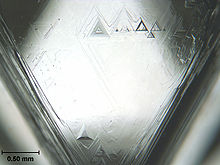
Diamonds occur most often as
Some diamonds contain opaque fibers. They are referred to as opaque if the fibers grow from a clear substrate or fibrous if they occupy the entire crystal. Their colors range from yellow to green or gray, sometimes with cloud-like white to gray impurities. Their most common shape is cuboidal, but they can also form octahedra, dodecahedra, macles, or combined shapes. The structure is the result of numerous impurities with sizes between 1 and 5 microns. These diamonds probably formed in kimberlite magma and sampled the volatiles.[20]
Diamonds can also form polycrystalline aggregates. There have been attempts to classify them into groups with names such as
Mechanical
Hardness
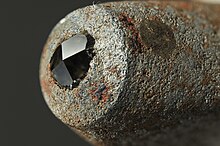
Diamond is the hardest material on the
Diamond hardness depends on its purity, crystalline perfection, and orientation: hardness is higher for flawless, pure crystals oriented to the <111> direction (along the longest diagonal of the cubic diamond lattice).[27] Therefore, whereas it might be possible to scratch some diamonds with other materials, such as boron nitride, the hardest diamonds can only be scratched by other diamonds and nanocrystalline diamond aggregates.
The hardness of diamond contributes to its suitability as a gemstone. Because it can only be scratched by other diamonds, it maintains its polish extremely well. Unlike many other gems, it is well-suited to daily wear because of its resistance to scratching—perhaps contributing to its popularity as the preferred gem in engagement or wedding rings, which are often worn every day.
The hardest natural diamonds mostly originate from the
Diamonds cut glass, but this does not positively identify a diamond because other materials, such as quartz, also lie above glass on the Mohs scale and can also cut it. Diamonds can scratch other diamonds, but this can result in damage to one or both stones. Hardness tests are infrequently used in practical gemology because of their potentially destructive nature.[29] The extreme hardness and high value of diamond means that gems are typically polished slowly, using painstaking traditional techniques and greater attention to detail than is the case with most other gemstones;[30] these tend to result in extremely flat, highly polished facets with exceptionally sharp facet edges. Diamonds also possess an extremely high refractive index and fairly high dispersion. Taken together, these factors affect the overall appearance of a polished diamond and most diamantaires still rely upon skilled use of a loupe (magnifying glass) to identify diamonds "by eye".[31]
Toughness
Somewhat related to hardness is another mechanical property toughness, which is a material's ability to resist breakage from forceful impact. The
Yield strength
Diamond has compressive yield strength of 130–140 GPa.
Elasticity and tensile strength
Usually, attempting to deform bulk diamond crystal by tension or bending results in brittle fracture. However, when single crystalline diamond is in the form of micro/nanoscale wires or needles (~100–300 nanometers in diameter, micrometers long), they can be elastically stretched by as much as 9–10 percent tensile strain without failure,[38] with a maximum local tensile stress of ~89 to 98 GPa,[39] very close to the theoretical limit for this material.[40]
Electrical conductivity
Other specialized applications also exist or are being developed, including use as
Substantial conductivity is commonly observed in nominally
Thin needles of diamond can be made to vary their electronic band gap from the normal 5.6 eV to near zero by selective mechanical deformation.[44]
High-purity diamond wafers 5 cm in diameter exhibit perfect resistance in one direction and perfect conductance in the other, creating the possibility of using them for quantum data storage. The material contains only 3 parts per million of nitrogen. The diamond was grown on a stepped substrate, which eliminated cracking.[45]
Surface property
Diamonds are naturally lipophilic and hydrophobic, which means the diamonds' surface cannot be wet by water, but can be easily wet and stuck by oil. This property can be utilized to extract diamonds using oil when making synthetic diamonds. However, when diamond surfaces are chemically modified with certain ions, they are expected to become so hydrophilic that they can stabilize multiple layers of water ice at human body temperature.[46]
The surface of diamonds is partially oxidized. The oxidized surface can be reduced by heat treatment under hydrogen flow. That is to say, this heat treatment partially removes oxygen-containing functional groups. But diamonds (sp3C) are unstable against high temperature (above about 400 °C (752 °F)) under atmospheric pressure. The structure gradually changes into sp2C above this temperature. Thus, diamonds should be reduced below this temperature.[47]
Chemical stability
At room temperature, diamonds do not react with any chemical reagents including strong acids and bases.
In an atmosphere of pure oxygen, diamond has an
Diamond powder of an appropriate grain size (around 50 microns) burns with a shower of sparks after ignition from a flame. Consequently, pyrotechnic compositions based on synthetic diamond powder can be prepared. The resulting sparks are of the usual red-orange color, comparable to charcoal, but show a very linear trajectory which is explained by their high density.[52] Diamond also reacts with fluorine gas above about 700 °C (1,292 °F).
Color

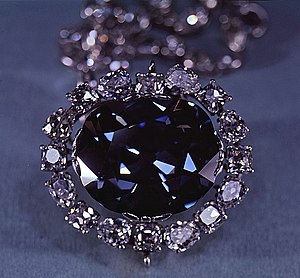
Diamond has a wide band gap of 5.5 eV corresponding to the deep ultraviolet wavelength of 225 nanometers. This means that pure diamond should transmit visible light and appear as a clear colorless crystal. Colors in diamond originate from lattice defects and impurities. The diamond crystal lattice is exceptionally strong, and only atoms of nitrogen, boron, and hydrogen can be introduced into diamond during the growth at significant concentrations (up to atomic percents). Transition metals nickel and cobalt, which are commonly used for growth of synthetic diamond by high-pressure high-temperature techniques, have been detected in diamond as individual atoms; the maximum concentration is 0.01% for nickel[53] and even less for cobalt. Virtually any element can be introduced to diamond by ion implantation.[54]
Nitrogen is by far the most common impurity found in gem diamonds and is responsible for the yellow and brown color in diamonds. Boron is responsible for the blue color.
In 2008, the
Clarity
Clarity is one of the 4C's (color, clarity, cut and carat weight) that helps in identifying the quality of diamonds. The Gemological Institute of America (GIA) developed 11 clarity scales to decide the quality of a diamond for its sale value. The GIA clarity scale spans from Flawless (FL) to included (I) having internally flawless (IF), very, very slightly included (VVS), very slightly included (VS) and slightly included (SI) in between. Impurities in natural diamonds are due to the presence of natural minerals and oxides. The clarity scale grades the diamond based on the color, size, location of impurity and quantity of clarity visible under 10x magnification.[61] Inclusions in diamond can be extracted by optical methods. The process is to take pre-enhancement images, identifying the inclusion removal part and finally removing the diamond facets and noises.[62]
Fluorescence
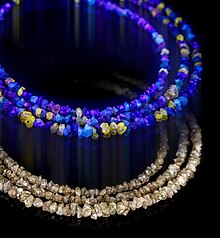

Between 25% and 35% of natural diamonds exhibit some degree of fluorescence when examined under invisible long-wave ultraviolet light or higher energy radiation sources such as X-rays and lasers.[63] Incandescent lighting will not cause a diamond to fluoresce. Diamonds can fluoresce in a variety of colors including blue (most common), orange, yellow, white, green and very rarely red and purple. Although the causes are not well understood, variations in the atomic structure, such as the number of nitrogen atoms present are thought to contribute to the phenomenon.
Thermal conductivity
Diamonds can be identified by their high thermal conductivity (900–2320 W·m−1·K−1).[64] Their high refractive index is also indicative, but other materials have similar refractivity.
Geology
Diamonds are extremely rare, with concentrations of at most parts per billion in source rock.
Most diamonds come from the Earth's mantle, and most of this section discusses those diamonds. However, there are other sources. Some blocks of the crust, or terranes, have been buried deep enough as the crust thickened so they experienced ultra-high-pressure metamorphism. These have evenly distributed microdiamonds that show no sign of transport by magma. In addition, when meteorites strike the ground, the shock wave can produce high enough temperatures and pressures for microdiamonds and nanodiamonds to form.[66] Impact-type microdiamonds can be used as an indicator of ancient impact craters.[67] Popigai impact structure in Russia may have the world's largest diamond deposit, estimated at trillions of carats, and formed by an asteroid impact.[68]
A common misconception is that diamonds form from highly compressed
Surface distribution
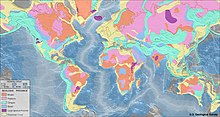
Diamonds are far from evenly distributed over the Earth. A rule of thumb known as Clifford's rule states that they are almost always found in
3).[66]
All three of the diamond-bearing rocks (kimberlite, lamproite and lamprophyre) lack certain minerals (melilite and kalsilite) that are incompatible with diamond formation. In kimberlite, olivine is large and conspicuous, while lamproite has Ti-phlogopite and lamprophyre has biotite and amphibole. They are all derived from magma types that erupt rapidly from small amounts of melt, are rich in volatiles and magnesium oxide, and are less oxidizing than more common mantle melts such as basalt. These characteristics allow the melts to carry diamonds to the surface before they dissolve.[66]
Exploration

Kimberlite pipes can be difficult to find. They weather quickly (within a few years after exposure) and tend to have lower topographic relief than surrounding rock. If they are visible in outcrops, the diamonds are never visible because they are so rare. In any case, kimberlites are often covered with vegetation, sediments, soils, or lakes. In modern searches, geophysical methods such as aeromagnetic surveys, electrical resistivity, and gravimetry, help identify promising regions to explore. This is aided by isotopic dating and modeling of the geological history. Then surveyors must go to the area and collect samples, looking for kimberlite fragments or indicator minerals. The latter have compositions that reflect the conditions where diamonds form, such as extreme melt depletion or high pressures in eclogites. However, indicator minerals can be misleading; a better approach is geothermobarometry, where the compositions of minerals are analyzed as if they were in equilibrium with mantle minerals.[66]
Finding kimberlites requires persistence, and only a small fraction contain diamonds that are commercially viable. The only major discoveries since about 1980 have been in Canada. Since existing mines have lifetimes of as little as 25 years, there could be a shortage of new diamonds in the future.[66]
Ages
Diamonds are dated by analyzing inclusions using the decay of radioactive isotopes. Depending on the elemental abundances, one can look at the decay of rubidium to strontium, samarium to neodymium, uranium to lead, argon-40 to argon-39, or rhenium to osmium. Those found in kimberlites have ages ranging from 1 to 3.5 billion years, and there can be multiple ages in the same kimberlite, indicating multiple episodes of diamond formation. The kimberlites themselves are much younger. Most of them have ages between tens of millions and 300 million years old, although there are some older exceptions (Argyle, Premier and Wawa). Thus, the kimberlites formed independently of the diamonds and served only to transport them to the surface.[20][66] Kimberlites are also much younger than the cratons they have erupted through. The reason for the lack of older kimberlites is unknown, but it suggests there was some change in mantle chemistry or tectonics. No kimberlite has erupted in human history.[66]
Origin in mantle

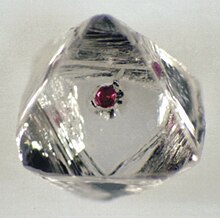
Most gem-quality diamonds come from depths of 150–250 km in the lithosphere. Such depths occur below cratons in mantle keels, the thickest part of the lithosphere. These regions have high enough pressure and temperature to allow diamonds to form and they are not convecting, so diamonds can be stored for billions of years until a kimberlite eruption samples them.[66]
Host rocks in a mantle keel include
A smaller fraction of diamonds (about 150 have been studied) come from depths of 330–660 km, a region that includes the transition zone. They formed in eclogite but are distinguished from diamonds of shallower origin by inclusions of majorite (a form of garnet with excess silicon). A similar proportion of diamonds comes from the lower mantle at depths between 660 and 800 km.[20]
Diamond is thermodynamically stable at high pressures and temperatures, with the phase transition from graphite occurring at greater temperatures as the pressure increases. Thus, underneath continents it becomes stable at temperatures of 950 degrees Celsius and pressures of 4.5 gigapascals, corresponding to depths of 150 kilometers or greater. In subduction zones, which are colder, it becomes stable at temperatures of 800 °C and pressures of 3.5 gigapascals. At depths greater than 240 km, iron–nickel metal phases are present and carbon is likely to be either dissolved in them or in the form of carbides. Thus, the deeper origin of some diamonds may reflect unusual growth environments.[20][66]
In 2018 the first known natural samples of a phase of ice called Ice VII were found as inclusions in diamond samples. The inclusions formed at depths between 400 and 800 km, straddling the upper and lower mantle, and provide evidence for water-rich fluid at these depths.[75][76]
Carbon sources
The mantle has roughly one billion gigatonnes of carbon (for comparison, the atmosphere-ocean system has about 44,000 gigatonnes).[77] Carbon has two stable isotopes, 12C and 13C, in a ratio of approximately 99:1 by mass.[66] This ratio has a wide range in meteorites, which implies that it also varied a lot in the early Earth. It can also be altered by surface processes like photosynthesis. The fraction is generally compared to a standard sample using a ratio δ13C expressed in parts per thousand. Common rocks from the mantle such as basalts, carbonatites, and kimberlites have ratios between −8 and −2. On the surface, organic sediments have an average of −25 while carbonates have an average of 0.[20]
Populations of diamonds from different sources have distributions of δ13C that vary markedly. Peridotitic diamonds are mostly within the typical mantle range; eclogitic diamonds have values from −40 to +3, although the peak of the distribution is in the mantle range. This variability implies that they are not formed from carbon that is primordial (having resided in the mantle since the Earth formed). Instead, they are the result of tectonic processes, although (given the ages of diamonds) not necessarily the same tectonic processes that act in the present.[66]
Formation and growth

Diamonds in the mantle form through a metasomatic process where a C–O–H–N–S fluid or melt dissolves minerals in a rock and replaces them with new minerals. (The vague term C–O–H–N–S is commonly used because the exact composition is not known.) Diamonds form from this fluid either by reduction of oxidized carbon (e.g., CO2 or CO3) or oxidation of a reduced phase such as methane.[20]
Using probes such as polarized light, photoluminescence, and cathodoluminescence, a series of growth zones can be identified in diamonds. The characteristic pattern in diamonds from the lithosphere involves a nearly concentric series of zones with very thin oscillations in luminescence and alternating episodes where the carbon is resorbed by the fluid and then grown again. Diamonds from below the lithosphere have a more irregular, almost polycrystalline texture, reflecting the higher temperatures and pressures as well as the transport of the diamonds by convection.[66]
Transport to the surface

Geological evidence supports a model in which kimberlite magma rises at 4–20 meters per second, creating an upward path by
Double diamonds

In rare cases, diamonds have been found that contain a cavity within which is a second diamond. The first double diamond, the Matryoshka, was found by Alrosa in Yakutia, Russia, in 2019.[78] Another one was found in the Ellendale Diamond Field in Western Australia in 2021.[79]
In space
Although diamonds on Earth are rare, they are very common in space. In meteorites, about three percent of the carbon is in the form of nanodiamonds, having diameters of a few nanometers. Sufficiently small diamonds can form in the cold of space because their lower surface energy makes them more stable than graphite. The isotopic signatures of some nanodiamonds indicate they were formed outside the Solar System in stars.[80]
High pressure experiments predict that large quantities of diamonds condense from methane into a "diamond rain" on the ice giant planets Uranus and Neptune.[81][82][83] Some extrasolar planets may be almost entirely composed of diamond.[84]
Diamonds may exist in carbon-rich stars, particularly white dwarfs. One theory for the origin of carbonado, the toughest form of diamond, is that it originated in a white dwarf or supernova.[85][86] Diamonds formed in stars may have been the first minerals.[87]
Industry

The most familiar uses of diamonds today are as gemstones used for adornment, and as industrial abrasives for cutting hard materials. The markets for gem-grade and industrial-grade diamonds value diamonds differently.
Gem-grade diamonds
The
A large trade in gem-grade diamonds exists. Although most gem-grade diamonds are sold newly polished, there is a well-established market for resale of polished diamonds (e.g. pawnbroking, auctions, second-hand jewelry stores, diamantaires, bourses, etc.). One hallmark of the trade in gem-quality diamonds is its remarkable concentration: wholesale trade and diamond cutting is limited to just a few locations; in 2003, 92% of the world's diamonds were cut and polished in
The production and distribution of diamonds is largely consolidated in the hands of a few key players, and concentrated in traditional diamond trading centers, the most important being Antwerp, where 80% of all rough diamonds, 50% of all cut diamonds and more than 50% of all rough, cut and industrial diamonds combined are handled.[91] This makes Antwerp a de facto "world diamond capital".[92] The city of Antwerp also hosts the Antwerpsche Diamantkring, created in 1929 to become the first and biggest diamond bourse dedicated to rough diamonds.[93] Another important diamond center is New York City, where almost 80% of the world's diamonds are sold, including auction sales.[91]
The
As a part of reducing its influence, De Beers withdrew from purchasing diamonds on the open market in 1999 and ceased, at the end of 2008, purchasing Russian diamonds mined by the largest Russian diamond company Alrosa.[100] As of January 2011, De Beers states that it only sells diamonds from the following four countries: Botswana, Namibia, South Africa and Canada.[101] Alrosa had to suspend their sales in October 2008 due to the global energy crisis,[citation needed] but the company reported that it had resumed selling rough diamonds on the open market by October 2009.[102] Apart from Alrosa, other important diamond mining companies include BHP, which is the world's largest mining company;[103] Rio Tinto, the owner of the Argyle (100%), Diavik (60%), and Murowa (78%) diamond mines;[104] and Petra Diamonds, the owner of several major diamond mines in Africa.

Further down the supply chain, members of The
Once purchased by Sightholders (which is a trademark term referring to the companies that have a three-year supply contract with DTC), diamonds are cut and polished in preparation for sale as gemstones ('industrial' stones are regarded as a by-product of the gemstone market; they are used for abrasives).[106] The cutting and polishing of rough diamonds is a specialized skill that is concentrated in a limited number of locations worldwide.[106] Traditional diamond cutting centers are Antwerp, Amsterdam, Johannesburg, New York City, and Tel Aviv. Recently, diamond cutting centers have been established in China, India, Thailand, Namibia and Botswana.[106] Cutting centers with lower cost of labor, notably Surat in Gujarat, India, handle a larger number of smaller carat diamonds, while smaller quantities of larger or more valuable diamonds are more likely to be handled in Europe or North America. The recent expansion of this industry in India, employing low cost labor, has allowed smaller diamonds to be prepared as gems in greater quantities than was previously economically feasible.[91]
Diamonds prepared as gemstones are sold on diamond exchanges called bourses. There are 28 registered diamond bourses in the world.[107] Bourses are the final tightly controlled step in the diamond supply chain; wholesalers and even retailers are able to buy relatively small lots of diamonds at the bourses, after which they are prepared for final sale to the consumer. Diamonds can be sold already set in jewelry, or sold unset ("loose"). According to the Rio Tinto, in 2002 the diamonds produced and released to the market were valued at US$9 billion as rough diamonds, US$14 billion after being cut and polished, US$28 billion in wholesale diamond jewelry, and US$57 billion in retail sales.[108]
Cutting
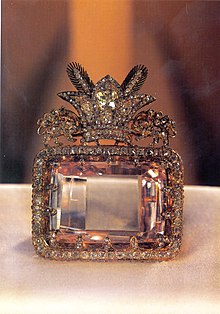
Mined rough diamonds are converted into gems through a multi-step process called "cutting". Diamonds are extremely hard, but also brittle and can be split up by a single blow. Therefore, diamond cutting is traditionally considered as a delicate procedure requiring skills, scientific knowledge, tools and experience. Its final goal is to produce a faceted jewel where the specific angles between the facets would optimize the diamond luster, that is dispersion of white light, whereas the number and area of facets would determine the weight of the final product. The weight reduction upon cutting is significant and can be of the order of 50%.
The most time-consuming part of the cutting is the preliminary analysis of the rough stone. It needs to address a large number of issues, bears much responsibility, and therefore can last years in case of unique diamonds. The following issues are considered:
- The hardness of diamond and its ability to cleave strongly depend on the crystal orientation. Therefore, the crystallographic structure of the diamond to be cut is analyzed using X-ray diffractionto choose the optimal cutting directions.
- Most diamonds contain visible non-diamond inclusions and crystal flaws. The cutter has to decide which flaws are to be removed by the cutting and which could be kept.
- Splitting a diamond with a hammer is difficult, a well-calculated, angled blow can cut the diamond, piece-by-piece, but it can also ruin the diamond itself. Alternatively, it can be cut with a
After initial cutting, the diamond is shaped in numerous stages of polishing. Unlike cutting, which is a responsible but quick operation, polishing removes material by gradual erosion and is extremely time-consuming. The associated technique is well developed; it is considered as a routine and can be performed by technicians.[113] After polishing, the diamond is reexamined for possible flaws, either remaining or induced by the process. Those flaws are concealed through various diamond enhancement techniques, such as repolishing, crack filling, or clever arrangement of the stone in the jewelry. Remaining non-diamond inclusions are removed through laser drilling and filling of the voids produced.[29]
Marketing
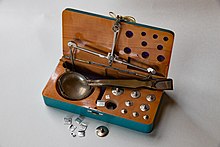
Marketing has significantly affected the image of diamond as a valuable commodity.
Brown-colored diamonds constituted a significant part of the diamond production, and were predominantly used for industrial purposes. They were seen as worthless for jewelry (not even being assessed on the diamond color scale). After the development of Argyle diamond mine in Australia in 1986, and marketing, brown diamonds have become acceptable gems.[118][119] The change was mostly due to the numbers: the Argyle mine, with its 35,000,000 carats (7,000 kg) of diamonds per year, makes about one-third of global production of natural diamonds;[120] 80% of Argyle diamonds are brown.[121]
Industrial-grade diamonds

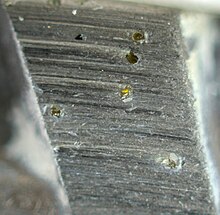
Industrial diamonds are valued mostly for their hardness and thermal conductivity, making many of the gemological characteristics of diamonds, such as the
The boundary between gem-quality diamonds and industrial diamonds is poorly defined and partly depends on market conditions (for example, if demand for polished diamonds is high, some lower-grade stones will be polished into low-quality or small gemstones rather than being sold for industrial use). Within the category of industrial diamonds, there is a sub-category comprising the lowest-quality, mostly opaque stones, which are known as bort.[124]
Industrial use of diamonds has historically been associated with their hardness, which makes diamond the ideal material for cutting and grinding tools. As the hardest known naturally occurring material, diamond can be used to polish, cut, or wear away any material, including other diamonds. Common industrial applications of this property include diamond-tipped drill bits and saws, and the use of diamond powder as an abrasive. Less expensive industrial-grade diamonds (bort) with more flaws and poorer color than gems, are used for such purposes.[125] Diamond is not suitable for machining ferrous alloys at high speeds, as carbon is soluble in iron at the high temperatures created by high-speed machining, leading to greatly increased wear on diamond tools compared to alternatives.[126]
Specialized applications include use in laboratories as containment for
Mining
Approximately 130,000,000 carats (26,000 kg) of diamonds are mined annually, with a total value of nearly US$9 billion, and about 100,000 kg (220,000 lb) are synthesized annually.[128]
Roughly 49% of diamonds originate from Central and Southern Africa, although significant sources of the mineral have been discovered in Canada, India, Russia, Brazil, and Australia.[123] They are mined from kimberlite and lamproite volcanic pipes, which can bring diamond crystals, originating from deep within the Earth where high pressures and temperatures enable them to form, to the surface. The mining and distribution of natural diamonds are subjects of frequent controversy such as concerns over the sale of blood diamonds or conflict diamonds by African paramilitary groups.[129] The diamond supply chain is controlled by a limited number of powerful businesses, and is also highly concentrated in a small number of locations around the world.
Only a very small fraction of the diamond ore consists of actual diamonds. The ore is crushed, during which care is required not to destroy larger diamonds, and then sorted by density. Today, diamonds are located in the diamond-rich density fraction with the help of X-ray fluorescence, after which the final sorting steps are done by hand. Before the use of X-rays became commonplace,[109] the separation was done with grease belts; diamonds have a stronger tendency to stick to grease than the other minerals in the ore.[34]


Historically, diamonds were found only in
Diamond extraction from primary deposits (kimberlites and lamproites) started in the 1870s after the discovery of the
In the U.S., diamonds have been found in
Today, most commercially viable diamond deposits are in Russia (mostly in
Political issues
In some of the more politically unstable central African and west African countries, revolutionary groups have taken control of diamond mines, using proceeds from diamond sales to finance their operations. Diamonds sold through this process are known as conflict diamonds or blood diamonds.[129]
In response to public concerns that their diamond purchases were contributing to war and
The Canadian Government has set up a body known as the Canadian Diamond Code of Conduct[142] to help authenticate Canadian diamonds. This is a stringent tracking system of diamonds and helps protect the "conflict free" label of Canadian diamonds.[143]
Mineral resource exploitation in general causes irreversible environmental damage, which must be weighed against the socio-economic benefits to a country.[144]
Synthetics, simulants, and enhancements
Synthetics
Synthetic diamonds are diamonds manufactured in a laboratory, as opposed to diamonds mined from the Earth. The gemological and industrial uses of diamond have created a large demand for rough stones. This demand has been satisfied in large part by synthetic diamonds, which have been manufactured by various processes for more than half a century. However, in recent years it has become possible to produce gem-quality synthetic diamonds of significant size.[65] It is possible to make colorless synthetic gemstones that, on a molecular level, are identical to natural stones and so visually similar that only a gemologist with special equipment can tell the difference.[145]
The majority of commercially available synthetic diamonds are yellow and are produced by so-called high-pressure high-temperature (
Another popular method of growing synthetic diamond is
As of 2010, nearly all 5,000 million carats (1,000 tonnes) of synthetic diamonds produced per year are for industrial use. Around 50% of the 133 million carats of natural diamonds mined per year end up in industrial use.[145][149] Mining companies' expenses average 40 to 60 US dollars per carat for natural colorless diamonds, while synthetic manufacturers' expenses average $2,500 per carat for synthetic, gem-quality colorless diamonds.[145]: 79 However, a purchaser is more likely to encounter a synthetic when looking for a fancy-colored diamond because only 0.01% of natural diamonds are fancy-colored, while most synthetic diamonds are colored in some way.[150]
-
Synthetic diamonds of various colors grown by the high-pressure high-temperature technique
-
Colorless gem cut from diamond grown by chemical vapor deposition
Simulants

A diamond simulant is a non-diamond material that is used to simulate the appearance of a diamond, and may be referred to as diamante. Cubic zirconia is the most common. The gemstone moissanite (silicon carbide) can be treated as a diamond simulant, though more costly to produce than cubic zirconia. Both are produced synthetically.[151]
Enhancements
Diamond enhancements are specific treatments performed on natural or synthetic diamonds (usually those already cut and polished into a gem), which are designed to better the gemological characteristics of the stone in one or more ways. These include laser drilling to remove inclusions, application of sealants to fill cracks, treatments to improve a white diamond's color grade, and treatments to give fancy color to a white diamond.[152]
Coatings are increasingly used to give a diamond simulant such as cubic zirconia a more "diamond-like" appearance. One such substance is diamond-like carbon—an amorphous carbonaceous material that has some physical properties similar to those of the diamond. Advertising suggests that such a coating would transfer some of these diamond-like properties to the coated stone, hence enhancing the diamond simulant. Techniques such as Raman spectroscopy should easily identify such a treatment.[153]
Identification

Early diamond identification tests included a scratch test relying on the superior hardness of diamond. This test is destructive, as a diamond can scratch another diamond, and is rarely used nowadays. Instead, diamond identification relies on its superior thermal conductivity. Electronic thermal probes are widely used in the gemological centers to separate diamonds from their imitations. These probes consist of a pair of battery-powered thermistors mounted in a fine copper tip. One thermistor functions as a heating device while the other measures the temperature of the copper tip: if the stone being tested is a diamond, it will conduct the tip's thermal energy rapidly enough to produce a measurable temperature drop. This test takes about two to three seconds.[154]
Whereas the thermal probe can separate diamonds from most of their simulants, distinguishing between various types of diamond, for example synthetic or natural, irradiated or non-irradiated, etc., requires more advanced, optical techniques. Those techniques are also used for some diamonds simulants, such as silicon carbide, which pass the thermal conductivity test. Optical techniques can distinguish between natural diamonds and synthetic diamonds. They can also identify the vast majority of treated natural diamonds.[155] "Perfect" crystals (at the atomic lattice level) have never been found, so both natural and synthetic diamonds always possess characteristic imperfections, arising from the circumstances of their crystal growth, that allow them to be distinguished from each other.[156]
Laboratories use techniques such as spectroscopy, microscopy, and luminescence under shortwave ultraviolet light to determine a diamond's origin.[155] They also use specially made instruments to aid them in the identification process. Two screening instruments are the DiamondSure and the DiamondView, both produced by the DTC and marketed by the GIA.[157]
Several methods for identifying synthetic diamonds can be performed, depending on the method of production and the color of the diamond. CVD diamonds can usually be identified by an orange fluorescence. D–J colored diamonds can be screened through the Swiss Gemmological Institute's[158] Diamond Spotter. Stones in the D–Z color range can be examined through the DiamondSure UV/visible spectrometer, a tool developed by De Beers.[156] Similarly, natural diamonds usually have minor imperfections and flaws, such as inclusions of foreign material, that are not seen in synthetic diamonds.
Screening devices based on diamond type detection can be used to make a distinction between diamonds that are certainly natural and diamonds that are potentially synthetic. Those potentially synthetic diamonds require more investigation in a specialized lab. Examples of commercial screening devices are D-Screen (WTOCD / HRD Antwerp), Alpha Diamond Analyzer (Bruker / HRD Antwerp), and D-Secure (DRC Techno).
Etymology, earliest use and composition discovery
The name diamond is derived from
Diamonds have been treasured as gemstones since their use as
In 1772, the French scientist Antoine Lavoisier used a lens to concentrate the rays of the sun on a diamond in an atmosphere of oxygen, and showed that the only product of the combustion was carbon dioxide, proving that diamond is composed of carbon.[162] Later in 1797, the English chemist Smithson Tennant repeated and expanded that experiment.[163] By demonstrating that burning diamond and graphite releases the same amount of gas, he established the chemical equivalence of these substances.[30]
See also
Citations
- S2CID 235729616.
- ^ a b "Diamond". Mindat. Archived from the original on May 6, 2009. Retrieved July 7, 2009.
- ^ "Diamond". WebMineral. Archived from the original on January 7, 2019. Retrieved July 7, 2009.
- ISBN 978-90-5699-228-6.
- ISBN 978-0-8155-1739-9.
- ISBN 978-1-61499-220-2.
- ^ ISBN 978-1-891389-32-0.
- ^ Gray T (October 8, 2009). "Gone in a Flash". Popular Science. Archived from the original on March 7, 2020. Retrieved October 31, 2018.
- ISBN 978-1-84996-408-1.
- ^ .
- ISBN 978-981-4241-52-6.
- PMID 16383918.
- PMID 16432191.
- ^ Bland E (January 15, 2010). "Diamond oceans possible on Uranus, Neptune". Discovery News. Archived from the original on March 11, 2012. Retrieved January 16, 2010.
- from the original on July 30, 2022. Retrieved November 9, 2020.
- ISBN 978-0-07-058369-6.
- ^ ISBN 978-0-03-083993-1.
- ISBN 978-0-8247-0987-7.
- ISBN 978-0-7506-1674-4.
- ^ .
- .
- S2CID 59405368.
- ^ "Diamonds from Outer Space: Geologists Discover Origin of Earth's Mysterious Black Diamonds". National Science Foundation. January 8, 2007. Archived from the original on December 9, 2007. Retrieved October 28, 2007.
- ^ "Diamonds Are Indestructible, Right?". Dominion Jewelers. December 16, 2015. Archived from the original on September 26, 2020. Retrieved October 31, 2020.
- ^ Weiler HD (April 13, 2021) [1954], The wear and care of records and styli, archived from the original on March 26, 2023, retrieved January 1, 2022 – via Shure
- ISBN 978-0-85296-785-0. Archivedfrom the original on February 19, 2023. Retrieved November 9, 2020.
- ^ Boser U (2008). "Diamonds on Demand". Smithsonian. 39 (3): 52–59. Archived from the original on March 2, 2012. Retrieved June 13, 2009.
- ^ ISBN 978-0-7506-6449-3. Archivedfrom the original on November 9, 2023. Retrieved November 9, 2020.
- ^ ISBN 978-0-521-65474-6.
- ISBN 978-0-7506-3173-0.
- ISBN 978-0-8493-3512-9.
- ISBN 978-0-8155-1424-4.
- ^ ISBN 978-0-521-62935-5.
- .
- ^ PMID 23093199.
- ^ a b Wogan T (November 2, 2012). "Improved diamond anvil cell allows higher pressures than ever before". Physics World. Nature Communications. Archived from the original on January 2, 2018. Retrieved July 1, 2022.
- S2CID 229935085.
- S2CID 5047604.
- S2CID 4986592.
- S2CID 202574625.
- doi:10.1063/1.101694.
- PMID 18999435.
- PMID 33020306.
- ^ Irving M (April 28, 2022). "Two-inch diamond wafers could store a billion Blu-Ray's worth of data". New Atlas. Retrieved April 29, 2022.
- (PDF) from the original on July 24, 2011.
- PMID 27264720.
- ISBN 978-0-486-15125-0.
- ^ "Diamond Care and Cleaning Guide". Gemological Institute of America. Archived from the original on August 1, 2019. Retrieved August 1, 2019.
- ^ Jones C (August 27, 2016). "Diamonds are Flammable! How to Safeguard Your Jewelry". DMIA. Archived from the original on August 1, 2019. Retrieved August 1, 2019.
- ^ Baird CS. "Can you light diamond on fire?". Science Questions with Surprising Answers. Archived from the original on August 1, 2019. Retrieved August 1, 2019.
- S2CID 104449284.
- .
- .
- (PDF) from the original on September 6, 2015.
- .
- ISBN 978-0-9728223-8-1.
- ^ Khan U (December 10, 2008). "Blue-grey diamond belonging to King of Spain has sold for record 16.3 GBP". The Daily Telegraph. London. Archived from the original on February 7, 2009. Retrieved March 31, 2010.
- ^ Nebehay S (May 12, 2009). "Rare blue diamond sells for record $9.5 million". Reuters. Archived from the original on May 16, 2009. Retrieved May 13, 2009.
- ^ Pomfret J (December 1, 2009). "Vivid pink diamond sells for record $10.8 million". Reuters. Archived from the original on December 2, 2020. Retrieved July 1, 2017.
- (PDF) from the original on April 18, 2021. Retrieved September 19, 2021.
- S2CID 203141270.
- ^ "Fact Checking Diamond Fluorescence: 11 Myths Dispelled". GIA 4Cs. March 27, 2018. Archived from the original on March 24, 2022. Retrieved June 6, 2022.
- PMID 10053956.
- ^ ISBN 978-0-87335-213-0.
- ^ .
- ISBN 978-0-08-044848-0. Archivedfrom the original on November 9, 2023. Retrieved November 9, 2020.
- .
- ^ King H (2012). "How do diamonds form? They don't form from coal!". Geology and Earth Science News and Information. geology.com. Archived from the original on October 30, 2013. Retrieved June 29, 2012.
- ^ Pak-Harvey A (October 31, 2013). "10 common scientific misconceptions". The Christian Science Monitor. Archived from the original on January 6, 2017. Retrieved August 30, 2017.
- ISBN 978-1-4443-9486-3.
- ISBN 978-0-19-174433-4.
- ^ Kjarsgaard BA (2007). "Kimberlite pipe models: significance for exploration" (PDF). In Milkereit B (ed.). Proceedings of Exploration 07: Fifth Decennial International Conference on Mineral Exploration. Decennial Mineral Exploration Conferences, 2007. pp. 667–677. Archived (PDF) from the original on December 24, 2012. Retrieved March 1, 2018.
- ^ doi:10.17863/CAM.44064. Archived from the original on December 17, 2019. Retrieved December 13, 2019.)
{{cite book}}: CS1 maint: location missing publisher (link - .
- ^ Perkins S (March 8, 2018). "Pockets of water may lie deep below Earth's surface". Science. Archived from the original on March 8, 2018. Retrieved June 30, 2022.
- S2CID 210787128.
- ^ Wei-Haas M (October 10, 2019). "Bizarre 'nesting doll' diamond found inside another diamond". National Geographic. Archived from the original on November 27, 2021. Retrieved November 27, 2021.
- ^ Fowler C (November 26, 2021). "Rare 'double diamond' discovery comes as race to restart mothballed Ellendale mine heats up". Australian Broadcasting Corporation. Archived from the original on November 26, 2021. Retrieved November 27, 2021.
- .
- S2CID 42814647.
- S2CID 120975663.
- ^ Kaplan S (August 25, 2017). "It rains solid diamonds on Uranus and Neptune". The Washington Post. Archived from the original on August 27, 2017. Retrieved October 16, 2017.
- ^ Max Planck Institute for Radio Astronomy (August 25, 2011). "A planet made of diamond". Astronomy magazine. Archived from the original on May 14, 2023. Retrieved September 25, 2017.
- .
- .
- ^ Wei-Haas M. "Life and Rocks May Have Co-Evolved on Earth". Smithsonian. Archived from the original on September 2, 2017. Retrieved September 26, 2017.
- ISBN 978-0-313-33507-5. Archivedfrom the original on November 9, 2023. Retrieved November 9, 2020.
- ^ Adiga A (April 12, 2004). "Uncommon Brilliance". Time. Archived from the original on March 10, 2007. Retrieved November 3, 2008.
- ^ "Jwaneng". Debswana. Archived from the original on March 17, 2012. Retrieved March 9, 2012.
- ^ ISBN 978-90-5702-420-7. Archivedfrom the original on November 9, 2023. Retrieved November 9, 2020.
- Spiegel Online. May 15, 2006. Archivedfrom the original on November 26, 2010. Retrieved November 29, 2010.
- ^ "The history of the Antwerp Diamond Center". Antwerp World Diamond Center. August 16, 2012. Archived from the original on February 22, 2013. Retrieved June 30, 2015.
- ^ "Commission Decision of 25 July 2001 declaring a concentration to be compatible with the common market and the EEA Agreement". Case No COMP/M.2333 – De Beers/LVMH. EUR-Lex. 2003. Archived from the original on May 12, 2011. Retrieved February 6, 2009.
- ^ "Business: Changing facets; Diamonds". The Economist. Vol. 382, no. 8517. 2007. p. 68. Archived from the original on May 12, 2011. Retrieved December 22, 2010.
- ^ "Certainty in the Diamond Industry? Watch Out For Tipping Points – IDEX's Memo". idexonline.com. Archived from the original on January 9, 2015. Retrieved September 24, 2014.
- ^ "The Elusive Sparcle". The Gem & Jewellery Export Promotion Council. Archived from the original on June 16, 2009. Retrieved April 26, 2009.
- ^ Even-Zohar C (November 6, 2008). "Crisis Mitigation at De Beers". DIB online. Archived from the original on May 12, 2011. Retrieved April 26, 2009.
- ^ Even-Zohar C (November 3, 1999). "De Beers to Halve Diamond Stockpile". National Jeweler. Archived from the original on July 5, 2009. Retrieved April 26, 2009.
- ^ "Judgment of the Court of First Instance of 11 July 2007 – Alrosa v Commission". EUR-Lex. 2007. Archived from the original on December 1, 2017. Retrieved April 26, 2009.
- ^ "Mining operations". The De Beers Group. 2007. Archived from the original on June 13, 2008. Retrieved January 4, 2011.
- ^ "Media releases – Media Centre – Alrosa". Alrosa. December 22, 2009. Archived from the original on August 20, 2013. Retrieved January 4, 2011.
- ^ "Another record profit for BHP". ABC News. August 22, 2007. Archived from the original on May 12, 2011. Retrieved August 23, 2007.
- ^ "Our Companies". Rio Tinto web site. Rio Tinto. Archived from the original on May 11, 2013. Retrieved March 5, 2009.
- ^ "Introduction | IDC". internationaldiamondcouncil.org. Archived from the original on October 18, 2022. Retrieved October 18, 2022.
- ^ ISBN 978-0-8213-6835-0. Archivedfrom the original on November 9, 2023. Retrieved November 9, 2020.
- ^ "Bourse listing". World Federation of Diamond Bourses. Archived from the original on October 25, 2016. Retrieved February 12, 2012.
- ^ "North America Diamond Sales Show No Sign of Slowing". A&W diamonds. Archived from the original on January 6, 2009. Retrieved May 5, 2009.
- ^ ISBN 978-0-8155-1339-1.
- ^ ]
- ^ "The Classical and Special Shapes of Diamonds". kristallsmolensk.com. Archived from the original on July 14, 2015. Retrieved July 14, 2015.
- ISBN 978-0-8247-9994-6. Archivedfrom the original on November 9, 2023. Retrieved November 9, 2020.
- from the original on November 9, 2023. Retrieved November 9, 2020.
- ^ Rapaport M. "Keep the Diamond Dream Alive". Rapaport Magazine. Diamonds.net. Archived from the original on September 13, 2012. Retrieved September 9, 2012.
- ^ a b JCK Staff (January 26, 2011). "10 Things Rocking the Industry". JCK. Jckonline.com. Archived from the original on January 7, 2013. Retrieved September 9, 2012.
- ^ a b Epstein EJ (1982). "Have You Ever Tried To Sell a Diamond?". The Atlantic. Archived from the original on May 17, 2008. Retrieved May 5, 2009.
- ^ Bates R (January 14, 2011). "Interview with Forevermark CEO". JCK. Jckonline.com. Archived from the original on November 28, 2012. Retrieved September 9, 2012.
- ISBN 978-0-521-62935-5.
- ISBN 978-0-87335-233-8.
- ^ "The Australian Diamond Industry". Archived from the original on July 16, 2009. Retrieved August 4, 2009.
- ISBN 978-0-87335-213-0.
- ^ "Diamond: The mineral Diamond information and pictures". minerals.net. Archived from the original on October 23, 2014. Retrieved September 24, 2014.
- ^ a b c "Industrial Diamonds Statistics and Information". United States Geological Survey. Archived from the original on May 6, 2009. Retrieved May 5, 2009.
- ^ ISBN 978-0-471-53589-8.
- ISBN 978-1-879335-39-4.
- .
- .
- ^ from the original on October 28, 2008. Retrieved October 3, 2006.
- ^ a b "Conflict Diamonds". United Nations. March 21, 2001. Archived from the original on March 9, 2010. Retrieved May 5, 2009.
- ^ Catelle WR (1911). The Diamond. John Lane Co. p. 159.
- ^ ISBN 978-1-4179-7715-4. Archivedfrom the original on November 9, 2023. Retrieved November 9, 2020.
- ^ Ball V (1881). "1". Diamonds, Gold and Coal of India. London: Trübner & Co. p. 1. Ball was a geologist in British service.
- ^ "Biggest diamond found in Panna". Mail Today. July 1, 2010. Archived from the original on July 7, 2011.
- ISBN 978-1-57958-453-5. Archivedfrom the original on November 9, 2023. Retrieved November 9, 2020.
- ^ .
- ^ a b Lorenz V (2007). "Argyle in Western Australia: The world's richest diamantiferous pipe; its past and future". Gemmologie, Zeitschrift der Deutschen Gemmologischen Gesellschaft. 56 (1–2): 35–40.
- ^ a b Cooke S (October 17, 2004). "Microscopic diamond found in Montana". The Montana Standard. Archived from the original on January 21, 2005. Retrieved May 5, 2009.
- ^ Marshall S, Shore J (2004). "The Diamond Life". Guerrilla News Network. Archived from the original on January 26, 2007. Retrieved March 21, 2007.
- doi:10.5741/GEMS.37.1.26. Archived from the original(PDF) on September 30, 2009. Retrieved February 20, 2010.
- ^ ISBN 978-3-928049-91-7. Archivedfrom the original on November 9, 2023. Retrieved November 9, 2020.
- ISBN 978-90-04-13656-4. Archivedfrom the original on November 9, 2023. Retrieved November 5, 2006.
- ^ "Voluntary Code of Conduct For Authenticating Canadian Diamond Claims" (PDF). Canadian Diamond Code Committee. 2006. Archived from the original (PDF) on February 29, 2012. Retrieved October 30, 2007.
- .
- ^ A meta-analysis of the environmental impact specific to diamond mining is in Oluleye G. Environmental Impacts of Mined Diamonds (PDF) (Report). Imperial College London Consultants. Archived (PDF) from the original on December 3, 2021. Retrieved July 1, 2022.
- ^ Bain & Company. Archived(PDF) from the original on January 31, 2012. Retrieved January 14, 2012.
- .
- .
- S2CID 250878100.
- ^ Pisani B (August 27, 2012). "The Business of Diamonds, From Mining to Retail". CNBC. Archived from the original on July 7, 2017. Retrieved September 9, 2017.
- ISBN 978-0-87335-233-8. Archivedfrom the original on November 9, 2023. Retrieved November 9, 2020.
- ISBN 978-0-7506-5512-5.
- ISBN 978-0-7506-4244-6. Archivedfrom the original on November 9, 2023. Retrieved November 9, 2020.
- ^ Shigley JE (2007). "Observations on new coated gemstones". Gemmologie: Zeitschrift der Deutschen Gemmologischen Gesellschaft. 56 (1–2): 53–56.
- ^ US 4488821, Wenckus JF, "Method and means of rapidly distinguishing a simulated diamond from natural diamond", published December 18, 1984, assigned to Ceres Electronics Corporation; U.S. patent 4,488,821
- ^ ISBN 978-0-85404-522-8. Archivedfrom the original on November 9, 2023. Retrieved November 9, 2020.
- ^ a b Welbourn C (2006). "Identification of Synthetic Diamonds: Present Status and Future Developments, Proceedings of the 4th International Gemological Symposium". Gems and Gemology. 42 (3): 34–35.
- ^ Donahue PJ (April 19, 2004). "DTC Appoints GIA Distributor of DiamondSure and DiamondView". Professional Jeweler Magazine. Archived from the original on March 6, 2012. Retrieved March 2, 2009.
- ^ "SSEF diamond spotter and SSEF illuminator". SSEF Swiss Gemmological Institute. Archived from the original on June 27, 2009. Retrieved May 5, 2009.
- Perseus Project. Archivedfrom the original on November 9, 2023. Retrieved February 20, 2021.
- ISBN 978-0-14-044413-1.
- ^ "Chinese made first use of diamond". BBC News. May 17, 2005. Archived from the original on March 20, 2007. Retrieved March 21, 2007.
- from the original on July 10, 2022, retrieved July 1, 2022
General and cited references
- Even-Zohar C (2007). From Mine to Mistress: Corporate Strategies and Government Policies in the International Diamond Industry (2nd ed.). Mining Journal Press. Archived from the original on March 10, 2020. Retrieved April 18, 2007.
- Davies G (1994). Properties and growth of diamond. INSPEC. ISBN 978-0-85296-875-8.
- O'Donoghue M (2006). Gems. Elsevier. ISBN 978-0-7506-5856-0.
- O'Donoghue M, Joyner L (2003). Identification of gemstones. Great Britain: Butterworth-Heinemann. ISBN 978-0-7506-5512-5.
- Feldman A, Robins LH (1991). Applications of Diamond Films and Related Materials. Elsevier. ISBN 978-1-48329124-6.
- Field JE (1979). The Properties of Diamond. London: Academic Press. ISBN 978-0-12-255350-9.
- Field JE (1992). The Properties of Natural and Synthetic Diamond. London: Academic Press. ISBN 978-0-12-255352-3.
- Hershey W (1940). The Book of Diamonds. Hearthside Press New York. ISBN 978-1-4179-7715-4. Archivedfrom the original on August 20, 2014. Retrieved August 18, 2011.
- Koizumi S, Nebel CE, Nesladek M (2008). Physics and Applications of CVD Diamond. Wiley VCH. ISBN 978-3-527-40801-6. Archivedfrom the original on November 9, 2023. Retrieved November 9, 2020.
- Pan LS, Kani DR (1995). Diamond: Electronic Properties and Applications. Kluwer Academic Publishers. ISBN 978-0-7923-9524-9.
- Pagel-Theisen V (2001). Diamond Grading ABC: the Manual. Antwerp: Rubin & Son. ISBN 978-3-9800434-6-5.
- Radovic RL, Walker RM, ISBN 978-0-8247-0987-7.
- Tolkowsky M (1919). Diamond Design: A Study of the Reflection and Refraction of Light in a Diamond. London: E. & F.N. Spon. Archived from the original on March 12, 2023. Retrieved March 13, 2007.
- Wise RW (2016). Secrets of the Gem Trade: The Connoisseur's Guide to Precious Gemstones (Second ed.). Brunswick House Press. ISBN 978-0-9728223-2-9. Archivedfrom the original on August 19, 2019. Retrieved May 11, 2021.
- Zaitsev AM (2001). Optical Properties of Diamond: A Data Handbook. Springer. ISBN 978-3-540-66582-3. Archivedfrom the original on November 9, 2023. Retrieved November 9, 2020.
Further reading
- Epstein EJ (February 1982). "Have You Ever Tried to Sell a Diamond?". The Atlantic Monthly. Archived from the originalon March 15, 2006. Retrieved January 2, 2023.
- Tyson P (November 2000). "Diamonds in the Sky". The Diamond Deception. Nova. PBS. Retrieved January 2, 2023.
External links
- Properties of diamond: Ioffe database
- ""A Contribution to the Understanding of Blue Fluorescence on the Appearance of Diamonds"". Gemological Institute of America (GIA). 2007. Archived from the original on September 8, 2017.


